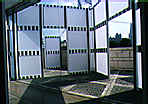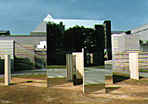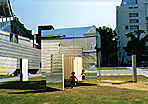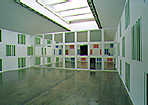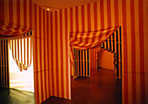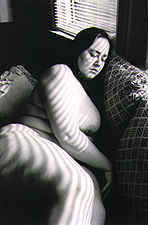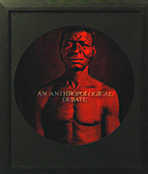
|
|
Oct. 29, 1996
|
Art Watch Index - Oct. 22, 1996
![]()
|
Daniel Buren Exhibition <<Transparence de la lumière: Travaux in situ>>

5 COULEURS POUR LA LUMIÈRE
DIFFUSER-CONCENTRER: BLANCHE EST LA LUMIÈRE. CABANE ÉCLATÉE ou: LE RÊVE MATINAL D'UN JEUNE HOMME
REFLÉTER-MIROITER: CABANE ÉCLATÉE POUR UNE FONTAINE
SÉPARER-DÉMULTIPLIER: BARRIÈRE À CLAIRE-VOIE
PROJETER-SOUFFLER: DÉAMBULATOIRE at Art Tower Mito, 1996
Art Tower Mito http://www.soum.co.jp/mito/
|
Daniel Buren Exhibition <<Transparence de la lumière: Travaux in situ>>
Daniel Buren's "Transparence de la lumiere: Travaux in situ", held at the Art Tower Mito Contemporary Art Center, until November 10, is a very educational exhibition. There, viewers remind themselves, through their visual experiences, that the art's fundamental role is to help us review the way the world should be. It also sheds light on today's not so transparent art societies in both Japan and overseas. Buren is a representative French contemporary artist who is famous for his work in which he decorates various parts of a town with colorful 8.7 cm-wide cloth strips. This may ring a bell for some Japanese that the man mentioned here is the artist whose name is pronounced "Danniel Buran". It is said that he "changed" the pronunciation of his name for this exhibition and for the occasion when he installed his work at the Tokyo Bay area, after finding out and being distressed that his name was pronounced differently in Japan. When Buren himself pronounces his own name, it does sound more like "Burenne". However, because his name is spelled "Buren" in French, he is often called "Buran" (this misunderstanding may not be helped since people's names are particular in pronunciation). In fact, not many people know how this artist has come to be known as "Buran". Although this problem has nothing to do with art, this is something not to be overlooked by art critics (and journalists) whose role is to clearly introduce contemporary art to the general public. The person who first introduced Buren to Japan (he or she must have been an art critic) should offer a word of explanation for this problem to take responsibility for his statement. "The site-specific work" using stripes as a motif Nevertheless, the art pieces in the exhibition are wonderful. Buren talks of the stripes, which have been his motif for nearly 30 years, as "visual tools rich in constructive and structural references", and "neutral signs with which any space can be measured". The supreme beauty of Buren's art is found in the piece called <SÉPARER-DÉMULTIPLIER: BARRIÈRE À CLAIRE-VOIE>, where the patterns are combined with mirrors, which he calls "the 'third eye' reflecting what our eyes cannot see". Another impressive point about the exhibition is that though the artist sometimes uses bamboo for the stripes, his work does not hint any influence of Japanese nature or culture. On the first day of the exhibition, at the press conference, he told the reason why he used bamboo was "not because (he) considered the bamboo as a symbol of Japan, but because of its unique character of changing its color continually after being cut down, and also because it is a precious and unavailable material in France". Buren introduces himself simply as being "born on March 25, 1938, living and working in 'the site of the artwork'". He said that "the starting point (of creation for this exhibition) was the natural light (of Art Tower Mito)". However, we should interpret his statement as meaning "a starting point for the subjective function of the artist towards the exhibition environment". This exhibition has a French sub-title, "Travaux in situ (the works created in situ)". The meaning of this is completely irrelevent from the movement in which overseas artists who have come to Japan for "artists in residence" programs (programs in which artists are invited and create works while residing at that place), make lighthearted attempts at referring to Japanese traditional culture and fail at that, and from "becoming free from Western modernism and reviewing the cultures local to specific regions", which are ideas becoming more and more prevalent in Japan and overseas. Buren's work becomes attractive, not only inside the museum but also in the city, because he grasps the nature of modern art, which is creating an autonomous expression constructed on the firmly established aesthetics of the individual artist. His works, which have escaped the museum and are sporadically seen "everywhere", are the embodiments of modern art. Today, an increasing number of young Japanese artists criticize art museums, but Buren says, "In the past 25 to 28 years, the art museum has been revolutionized. Authoritarianism has seen its demise, and it has become an unprecedented place for experimental work". [Satoru NAGOYA/Art Journalist]
|
|
|
|
<<Gender-Beyond Memory>>
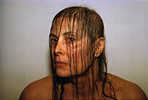
Hannah Wilke
Laurie Toby Edison
Carrie Mae Weems Photo: Catalogue of <<Gender-Beyond Memory>>, Tokyo Metropolitan Museum of Photography
Hannah Wilke http://www.arts.ucsb.edu/ terminals/coils/wilke.html
Hannah Wilke - Reference Page
Women En Large Home Page
Yoshiko Shimada(in Japanese)
Yoshiko Shimada
Contemporary Arts Museum, Houston: Carrie Mae Weems
|
Photograph As a "Trans-gender"
Encountering the Exhibition of Contemporary Female Artists
Expression through photographs and theories over photographs are about to go through major changes regarding the expression of women. These changes do not imply something so simple, such as the increasingly prevalent expressions by "women", who have been considered and surpressed as a minority. Here, the issue of the visual system in photography has become exposed. In other words, the issue of whether the relationship of those who watch and those who are watched, functions as the power structure that holds down the minority has been indicated. So, in what framework does a photographer position oneself when taking photographs? From what kind of stance does the critic observe the photographs? What does being a "male" or a "female" mean in such a situation? When photography faces a time of trial by political arguments over sexuality and gender, the frameworks like "art" and "artwork" that have been clinging onto the conventional image derived from photography, could be on the verge of deconstruction. The works of the "Contemporary Female Artists" Exhibition, <<Gender- Beyond Memory>>, held at the Tokyo Metropolitan Museum of Photography, presents such questions. The image of women in this exhibition is not that of a beautiful goddess often created by the male gender. For example, in the <Intra-Venus Series>, Hannah Wilke shows her own swollen body that has deterioated with cancer, and Laurie Toby Edison displays bodies of fat women as opposed to slender ones that the modern media expect of women. These are a complete departure from the conventional "artistic" concept of "beauty". However, the photographs point out that these concepts of "art" and "aesthetics" are not universal and that they are concepts that have been created by "men". The political aspect of the image of a "mother" As the feminist movements since the '70's have proved, images of the "ideal women" that are expected by men have unconsciously been forced on us through variuos media today, and have even penetrated the minds of women (actually, the same can be said of "men"). For example, the "mother and child" image of magazine advertisements, posters, TV drama, commercials and photographs seem to indirectly imply that a women's greatest happiness is to get married and bear children. Even if women entered into politics in order to expand the women's rights, the stereotypical image of a "mother" is reinforced, as reflected in the catchphrases such as "bring in the housewives' viewpoint into politics" or "don't send children to war". Regardless of what kind of individual problems a mother and a child may have, photography has the power to subordinate them into the expected social image. In other words, though in goodwill, the visions of photography embody the male-centered ideology. There may be opinions that rather than fight against that image for the independence of women, it is much easier to follow it, and that there is nothing wrong in being more comfortable. However, Yoshiko SHIMADA makes it clear in this exhibition that such an image of a "mother" is partly the cause which led (Japan) into the war of aggression, creating the issue of the "comfort women". By re-questioning the works in a political, historical and social context, the myth of the autonomy of art and the neutrality of artworks are about to be deconstructed. Artworks, including photography, can no longer be described only from an aesthetic viewpoint, but they must be thrown into the relationship between art and reality. The ambiguous power of photography On the other hand, was not photography originally a political media (in a broader definition)? No matter how much the photographer tries to reflect his aesthetic image on his works, as long as the photograph cannot be seperated from the realistic subject, it will betray his intention, conceiving a deviated image. For example, when the nude photograph was introduced in the 19th century using the daguerreotype photography, people tried to see in the photograph, a vulgar, vivid, and direct reality not existing in the nude depiction of a painting (this was more an expression of the idea of "beauty" rather than a realistic, naked body). Therefore, photography had emerged as a true "minority" media that broke through the norms of beauty, which had existed as the majority. In that sense, this exhibition holds great significance in that it endeavours to take another look at the potentials and possibilities carried by photography. However, just as the problem over the gender does not become solved by changing from "women" to "men", it does not mean that these works, which attempt to influence the conventional value systems through images including photographs (whether such an expression is appropriate or not), can be accepted as a new "aesthetics" simply because they are exhibited inside a museum. If this new beauty becomes absorbed by the regime of conventional "fine art" and "art", and becomes a model for one kind of "beauty", we will still need a renewed resistance against it. If the idea of being a "man" or a "woman" must be liberated from the fixation of the normative identity, the expression which does not rely on any model that exists as a majority (of course, this is not a matter of just numbers) will be the one to contribute. Photography exists as an ambiguous medium which can become a weapon for that cause, or become one which suppresses it. We must keep in mind that this exhibition itself also carries such an ambiguity. [Akihito YASUMIi/Critic]
|
|
|
|
|
|
|
|
|
Oct. 29, 1996
|
[home]/[Art Information]/[Column]
[nmp Forum]
Copyright (c) Dai Nippon Printing Co., Ltd. 1996
Network Museum & Magazine Project / nmp@acs.dnp.co.jp
